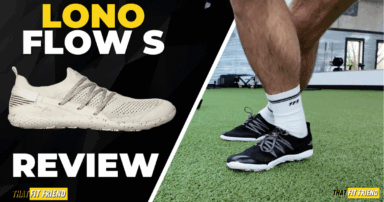The stiff-leg deadlift, referred to by some as the straight-leg deadlift, is one of my favorite deadlift variations for multiple reasons. This is a deadlift variation that can have awesome carryover for your normal deadlift.
If you’ve been wanting to improve your deadlift strength and find that you’re weak off of the floor, then it may be time to implement more stiff-leg deadlifts.
The stiff-leg deadlift is a deadlift variation that is great for focusing on building strength off of the floor and training the hips to be strong in certain positions. This variation will entail a higher hip position compared to traditional deadlifts.
Stiff-Leg Deadlift Muscles Worked
The stiff-leg deadlift will heavily focus on the posterior muscles. Since the hips are higher with this deadlift variation you’ll have a lot of glutes and hamstrings off of the floor whereas you’ll have a little more quad in the traditional deadlift.
When performing stiff-leg deadlifts, you should “feel” these pretty heavily in the glutes, hamstrings, and somewhat in your erectors. If your erectors are on fire or feel like they’re blown up after stiff-leg deadlifts then something may be off with your setup and brace.
I coach “passively” feeling the erectors as opposed to feeling like they’re doing the majority of the lifting. We want a balanced stimulus across the posterior muscles.
Stiff-Leg Deadlift Benefits
In my coaching opinion, the stiff-leg deadlift is a constantly overlooked deadlift variation. When used correctly and with strategy there are a lot of benefits that can come along with performing stiff-leg deadlifts.
Benefit 1: Increase Strength Off of the Floor
The first benefit and rationale as to why I’ll program stiff-leg deadlifts for myself and my clients is when there’s a focus and want to build more strength off of the floor.
How you break the floor in your deadlift can make or break successful pulls. Breaking the floor in a deadlift is a term to describe the first range of motion where the barbell moves off of the floor.
The stiff-leg deadlift is great for focusing on strength off the floor because the higher hip position is going to put you in a disadvantaged position. Essentially, you have less leverage off of the floor with stiff-leg deadlifts because you have less quad involvement.
This is great because it can help teach lifters to be patient with their hips off of the floor but also bias and focus on what the posterior muscles are doing throughout the concentric range of motion.
Benefit 2: Improve Hip Mechanics
Another benefit of stiff-leg deadlifts is that they can be a great tool for teaching hip mechanics in the deadlift. The ability to shift your hips into different positions based on the exercise you’re performing is a superpower.
For example, can you fluidly flow from a deadlift, Romanian deadlift, and stiff-leg deadlift and nail your hip mechanics in every deadlift variation to ensure you’re completing rep with proficiency?

If you find that your hips are “eager” in your deadlift or like they’re not able to maintain a strong and consistent set position, then it may be worth programming more stiff-leg deadlifts.
The hips and their position will make or break stiff-leg deadlift reps. I often program stiff-leg deadlifts for lifters that constantly feel like they’re blowing up their erectors when performing traditional deadlifts.
A stiff-leg deadlift will naturally teach a lifter how to maintain a stronger set position between the torso and hips because if they’re not, then reps will feel brutally hard so the body will typically self-organize accordingly without too much over-analyzation and coaching.
Stiff-Leg Deadlift Mistakes
The devil’s in the details when it comes to getting the most out of your stiff-leg deadlifts. Below are some of the most common mistakes that I’ll see lifters make with stiff-leg deadlifts.
Mistake 1: Bending the Knees Too Much
The first and most common mistake that I see lifters make with stiff-leg deadlifts is bending the knees too much. If you’re bending the knees a lot in the stiff-leg deadlift then you’re nullifying the point of performing this exercise in the first place.
Overly flexed knees will result in more quad involvement and will detract from giving more of a stimulus to muscles like the glutes, hamstrings, and erectors.
Additionally, overly flexed knees will change how you’re breaking the floor with this exercise and take away from how you’re training the hips to maintain their position.
How To Fix This
To fix this, video yourself from the side and pay attention to your torso position. Ideally, you want the torso to be relatively parallel to the floor. I say relatively because arm and leg length can create some variance here.
If your torso is angled upwards, then you may be bending the knees too much and sitting too low. With a parallel torso position, generally speaking, the hips will naturally fall into the position that they need to be.
Another useful way to fix this mistake is to “feel” your hamstrings and glutes when getting set in your stiff-leg deadlifts. If you’re barely bending the knees and feel tension throughout the back of your legs then you’re likely in a good position.
Mistake 2: Starting With the Bar Too Close to the Body
In the traditional barbell deadlift, you’ll want to start with the barbell relatively close to the body. I say relatively because you ideally want the barbell to track over the midfoot for balance purposes but you don’t want it so close to where you’re creating a ton of friction on the body.
The stiff-leg deadlift’s setup and starting position will be different because the barbell should be farther away from the body. Generally speaking, you’ll want the barbell to sit over the toes or just in front of them.
This will allow you to maintain proper hip mechanics, if the barbell is too close to the body then it’s nearly impossible for most lifters to maintain a high hip position with a neutral spine.
How To Fix This
In short, bring the barbell forward and make sure it’s around your toes before each rep. Another method for fixing this mistake is to film yourself from the side and check your torso and arm angle.
Ideally, you want the arms relatively perpendicular to the floor with a neutral spine that’s roughly parallel to the floor. By videoing your lifts from the side, it can be a little easier to track and adjust your form.
Stiff-Leg Deadlift Vs Romanian Deadlift (RDL)
The stiff-leg deadlift versus the Romanian deadlift (RDL) is always a fun comparison because both of these deadlift variations are awesome in their own right and they each have their own lists of pros and cons.
Generally speaking, there are three major differences that I like to discuss between the stiff-leg deadlift versus the Romanian deadlift. These differences can influence when and why you’d program each exercise.
- Difference 1: Starting positions. The stiff-leg deadlift will start every rep from the floor which will give them a concentric (lifting) bias. The RDL will start reps from a locked-out position and they’ll be much more eccentric (lowering) biased.
- Difference 2: Muscle Actions. The stiff-leg deadlift will focus heavily on the shortening of the glutes, hamstrings, and erectors, whereas the RDL will focus heavily on the lengthening and passively on the shortening of these muscles.
- Difference 3: Training Goals. The stiff-leg deadlift is great for focusing on building strength off of the floor whereas the RDL can be awesome for building hip hinge strength and focusing on hamstrings and glutes hypertrophy.
Takeaway Thoughts
The stiff-leg deadlift is one of my favorite deadlift variations for building hip strength and strength off of the floor. I also like that this is a deadlift variation that can be useful for teaching lifters how to better leverage their hips.
I also like that the stiff-leg deadlift can be an awesome tool for building Python-like erectors when used and programmed correctly.
If you have additional questions about stiff-leg deadlifts and how to use and program them properly, drop a comment below or reach out to me personally via Instagram (@jake_boly or @that_fit_friend).


















Add a Comment